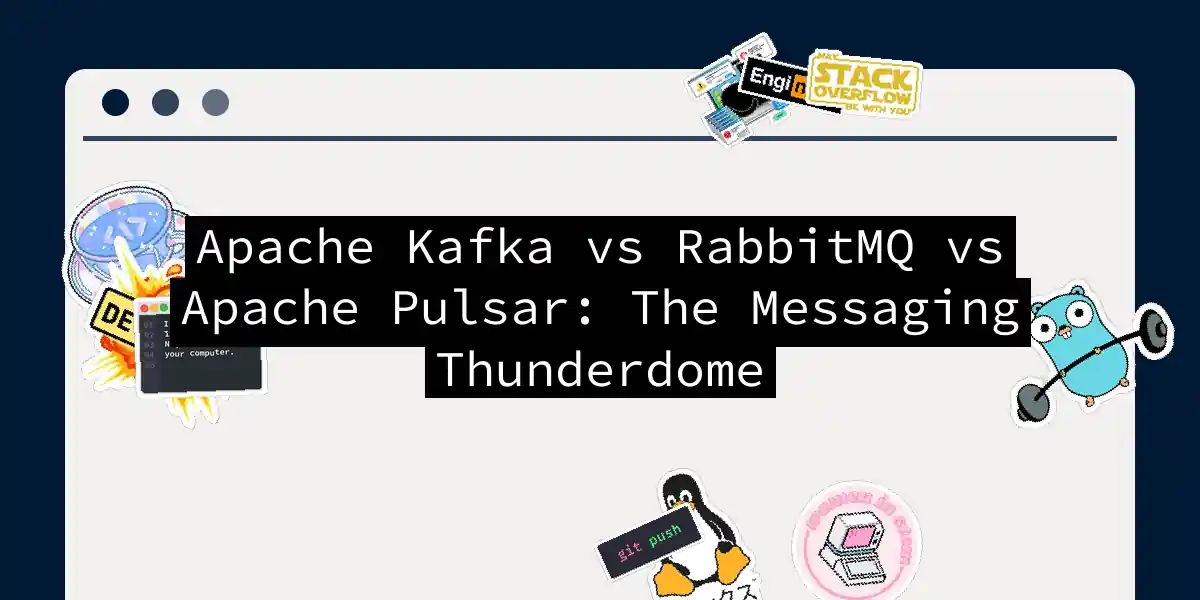When your microservices start gossiping like teenagers at a sleepover, you need a messaging system that won’t drop the drama. Apache Kafka, RabbitMQ, and Apache Pulsar are the heavyweight champions in this arena, each with their own fighting style. Let’s break down their strengths, weaknesses, and secret weapons – with actual code to prove it’s not just theoretical fluff.
Core Philosophies: What’s Under the Hood?
RabbitMQ is your reliable old-school postman. Built around the AMQP protocol, it treats messages like registered letters – guaranteed delivery with routing slip precision. Perfect for:
# RabbitMQ producer example
import pika
connection = pika.BlockingConnection(pika.ConnectionParameters('localhost'))
channel = connection.channel()
channel.queue_declare(queue='order_queue')
channel.basic_publish(exchange='', routing_key='order_queue', body='Order #42')
Apache Kafka is the town crier on steroids. It screams events into distributed commit logs:
// Kafka producer snippet
Properties props = new Properties();
props.put("bootstrap.servers", "kafka-broker:9092");
props.put("key.serializer", "org.apache.kafka.common.serialization.StringSerializer");
props.put("value.serializer", "org.apache.kafka.common.serialization.StringSerializer");
Producer<String, String> producer = new KafkaProducer<>(props);
producer.send(new ProducerRecord<>("user_events", "user123", "clicked_button"));
Apache Pulsar is the futuristic cyborg postman. Its layered architecture separates compute from storage using BookKeeper:
Performance Showdown: Raw Numbers
| Metric | RabbitMQ | Kafka | Pulsar |
|---|---|---|---|
| Max Throughput | ~30K msgs/sec | 200MB+/sec | ~100MB/sec |
| Latency (p99.9) | Lowest at low load | 15x faster than Rabbit | Higher than Kafka |
| Scalability | Vertical only | Horizontal partitions | Multi-tenant clusters |
| Data Retention | Queue-based | Time-based retention | Tiered storage |
Kafka dominates throughput tests like it’s an all-you-can-eat buffet, while Pulsar’s tiered storage handles long-term data like a digital hoarder with organization skills.
Deployment War Stories
When RabbitMQ Shines
That time our payment service needed dead-letter queues for failed transactions:
# Dead letter exchange setup
rabbitmqctl set_policy DLX ".*" '{"dead-letter-exchange":"dlx"}' --apply-to queues
Rabbit’s flexibility saved us when dealing with poisonous messages – like a bouncer removing troublemakers from the club.
Kafka’s Big Data Dominance
Ingesting IoT sensor data at scale became trivial with Kafka Connect:
bin/connect-standalone.sh config/connect-standalone.properties config/iot-source.properties
Kafka Streams then transformed this data like a digital assembly line.
Pulsar’s Geo-Replication Win
Multi-region deployment required just one command:
pulsar-admin clusters create cluster-b --broker-url pulsar://cluster-b:6650
Suddenly our Tokyo and New York offices weren’t fighting over bandwidth.
The “Which Should I Use?” Flowchart
Debugging Nightmares: A Shared Hallucination
Ever seen a Kafka partition imbalance? Like watching one checkout lane at Walmart with 50 people while others sit empty. Fix it with:
kafka-topics --alter --topic orders --partitions 6
RabbitMQ queue buildup? It’s the digital equivalent of clogged arteries. Unblock with:
rabbitmqctl purge_queue order_backlog
Pulsar ledger errors? Like finding a library book misfiled in the cookbook section. Heal with:
pulsar-admin bookkeeper recover
Future-Proofing Your Choice
While Kafka dominates today’s event streaming, Pulsar’s cloud-native design is like a Tesla versus Kafka’s combustion engine. RabbitMQ? That reliable bicycle that always gets you there – just don’t try to win the Tour de France with it. The real winner? The one that matches your team’s operational stamina. Because no messaging system survives contact with production without scars.
